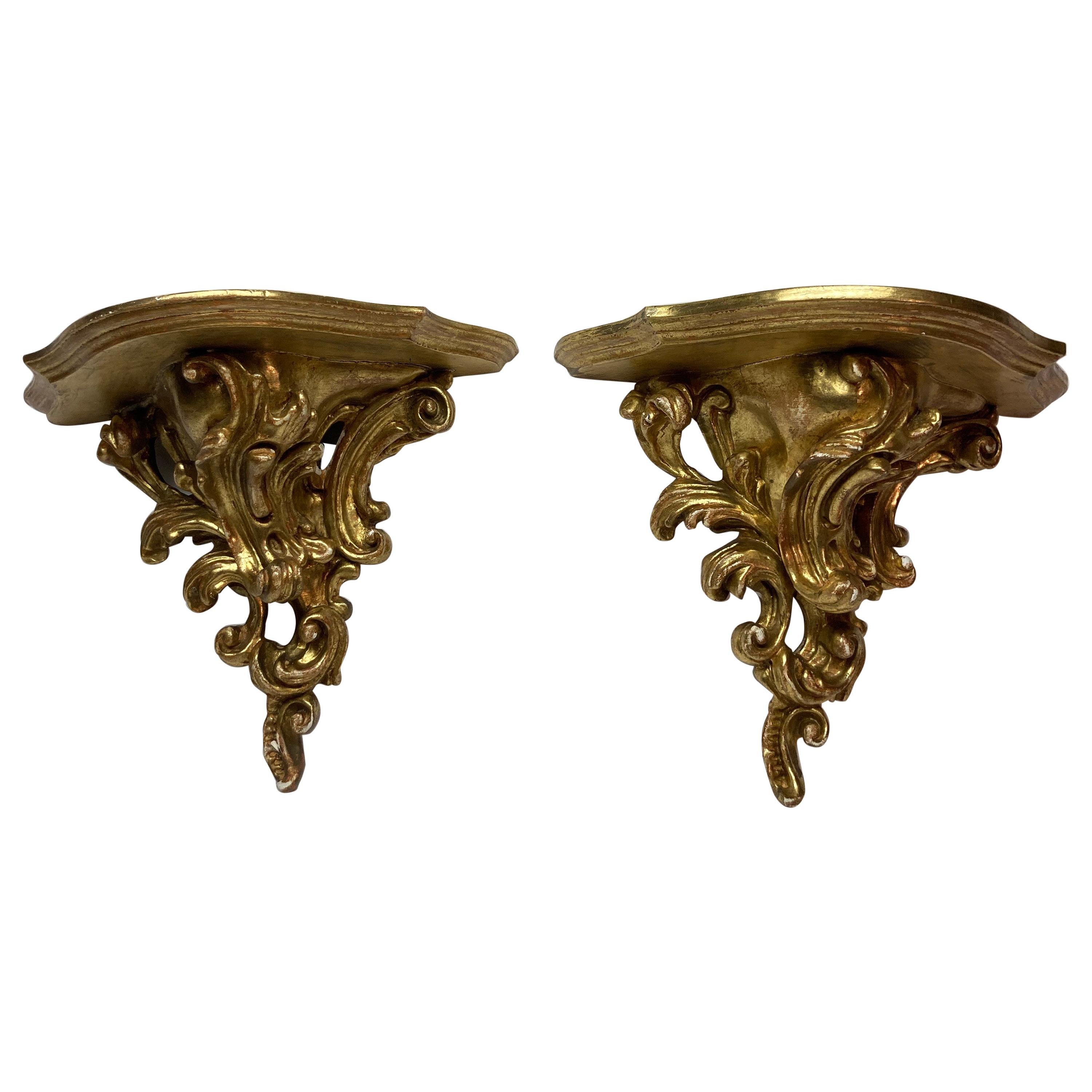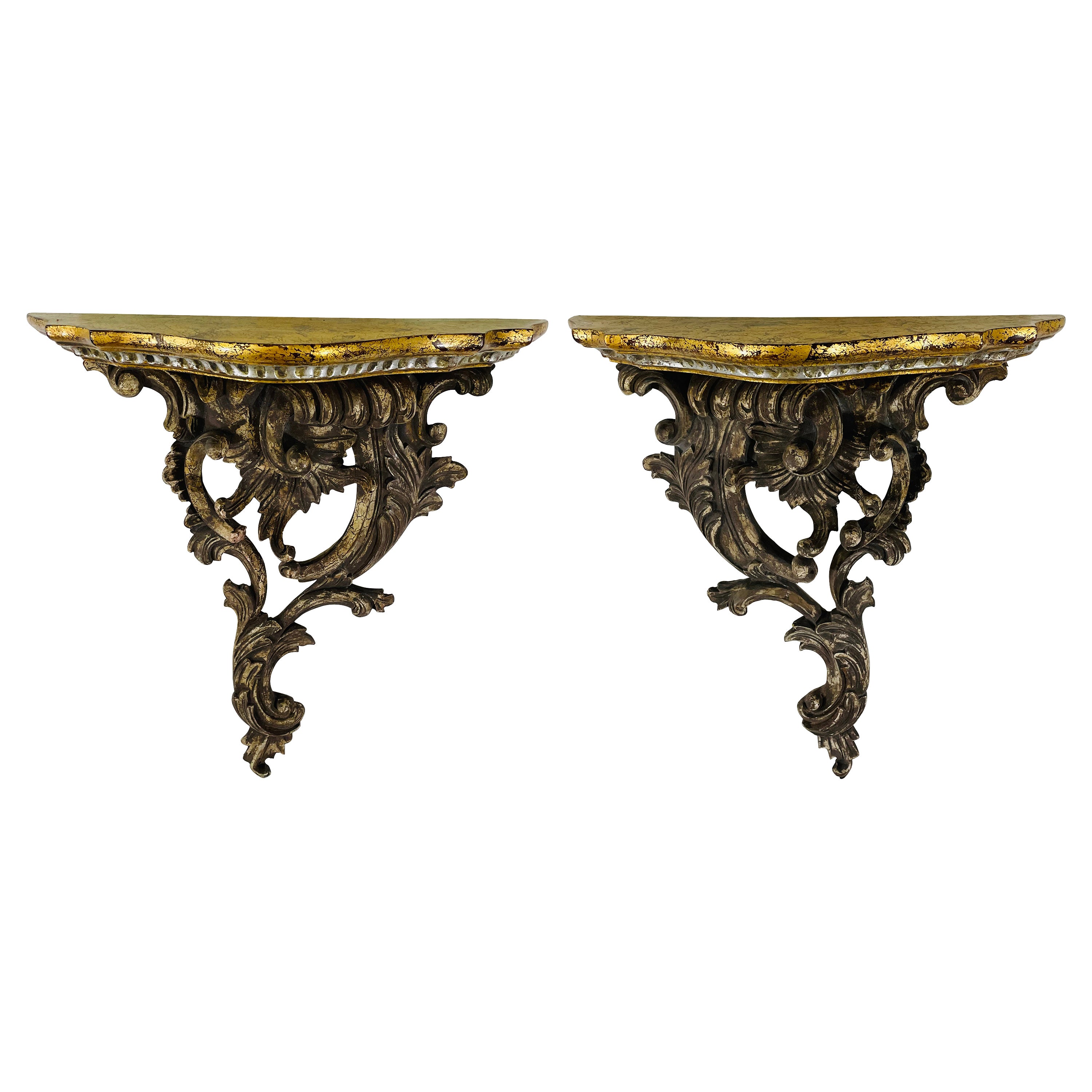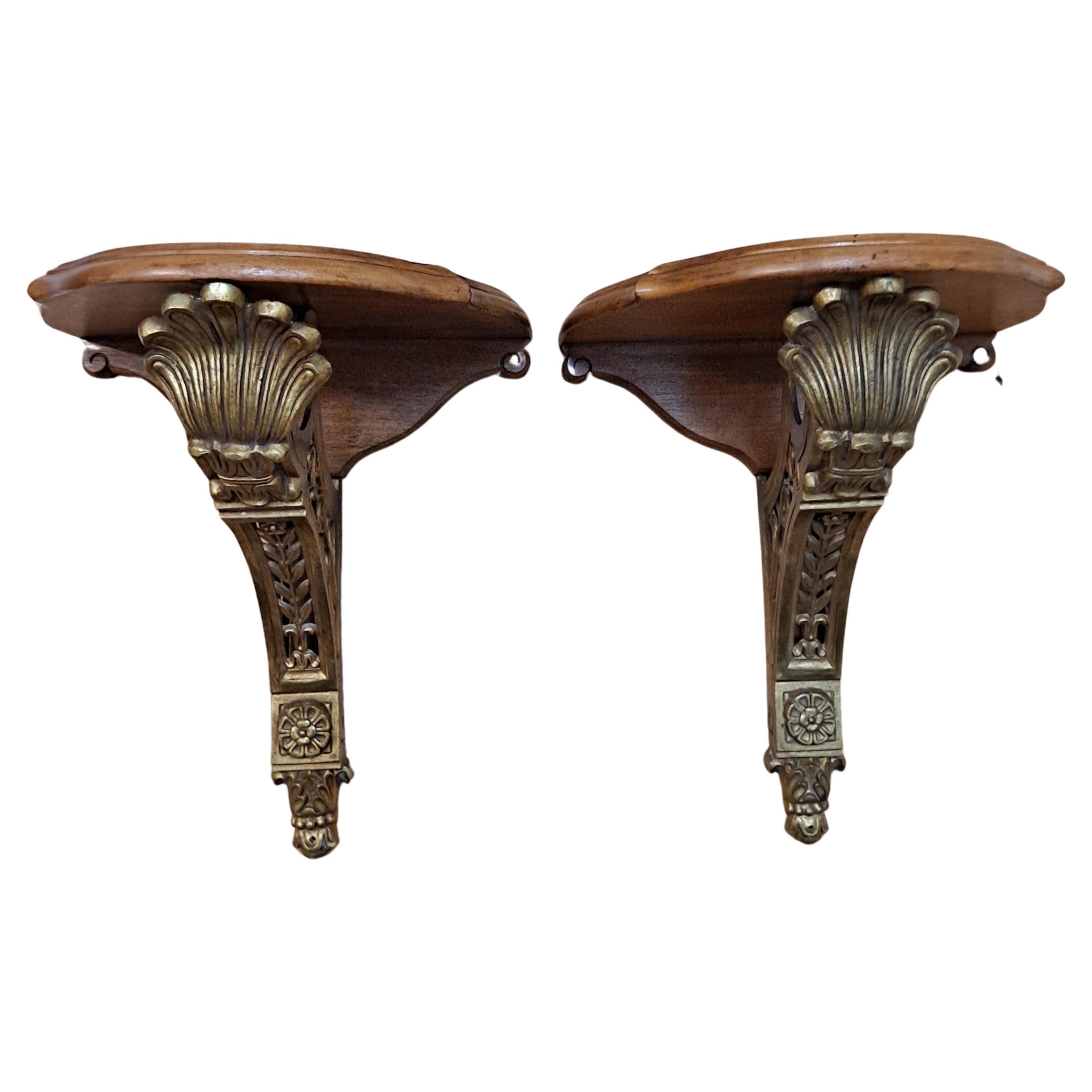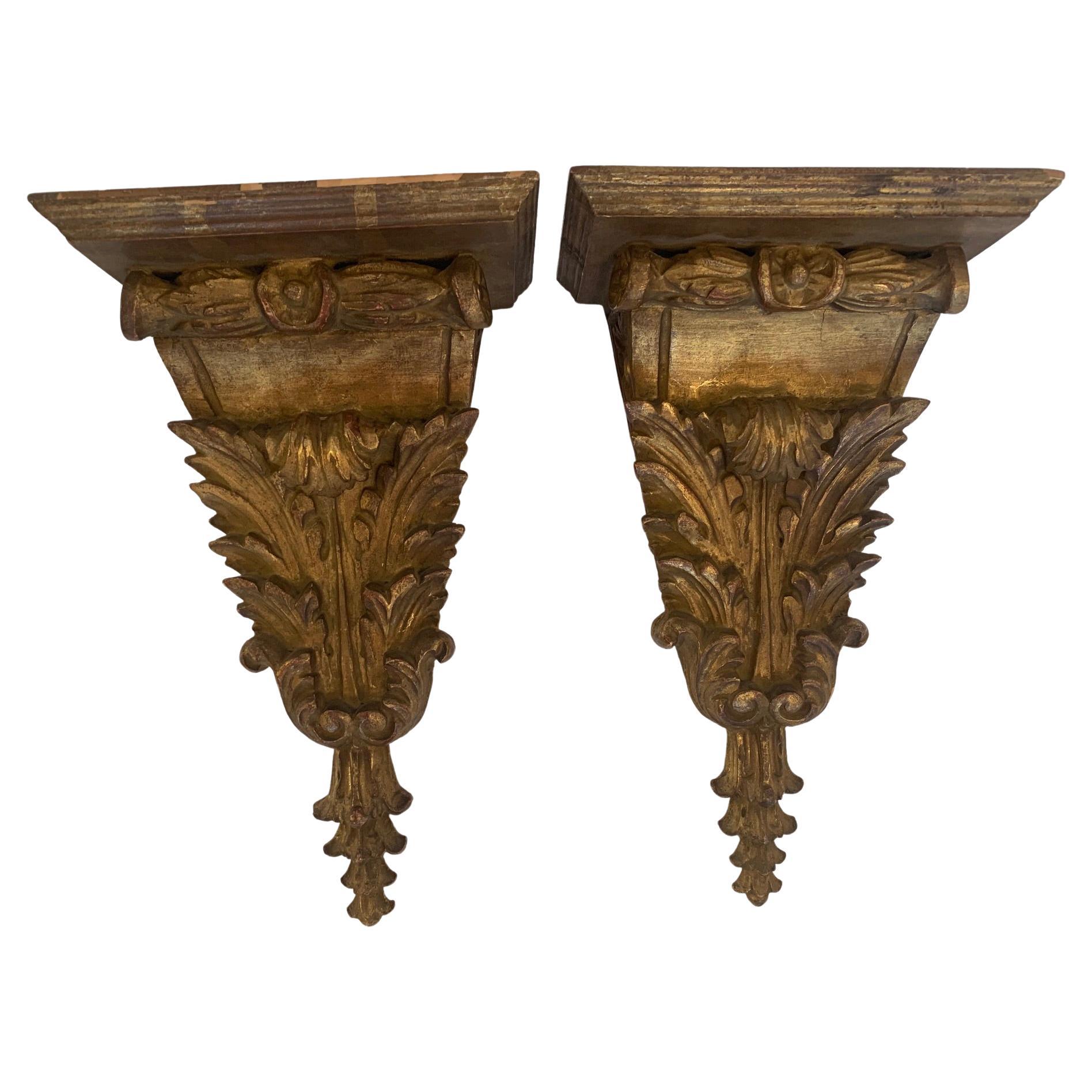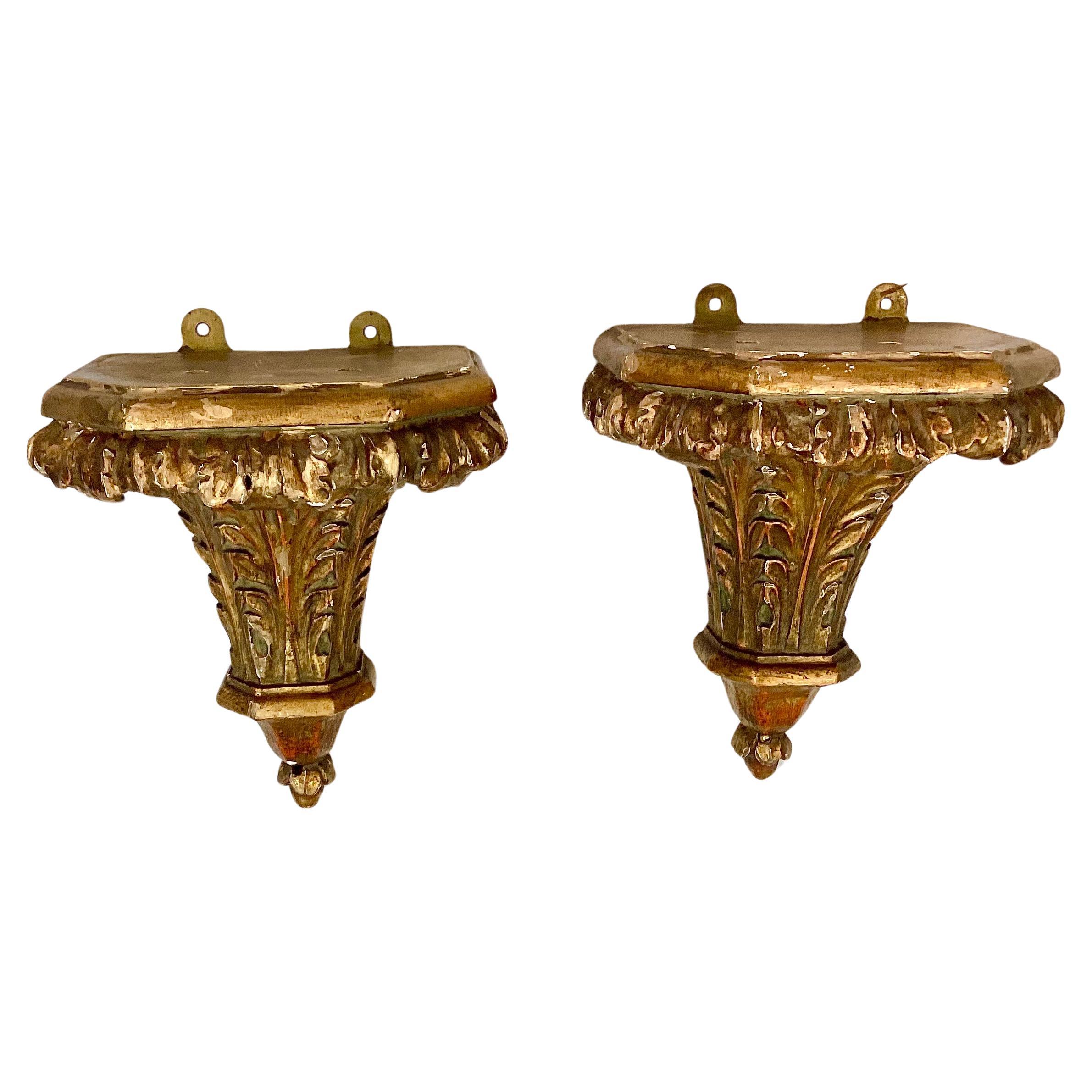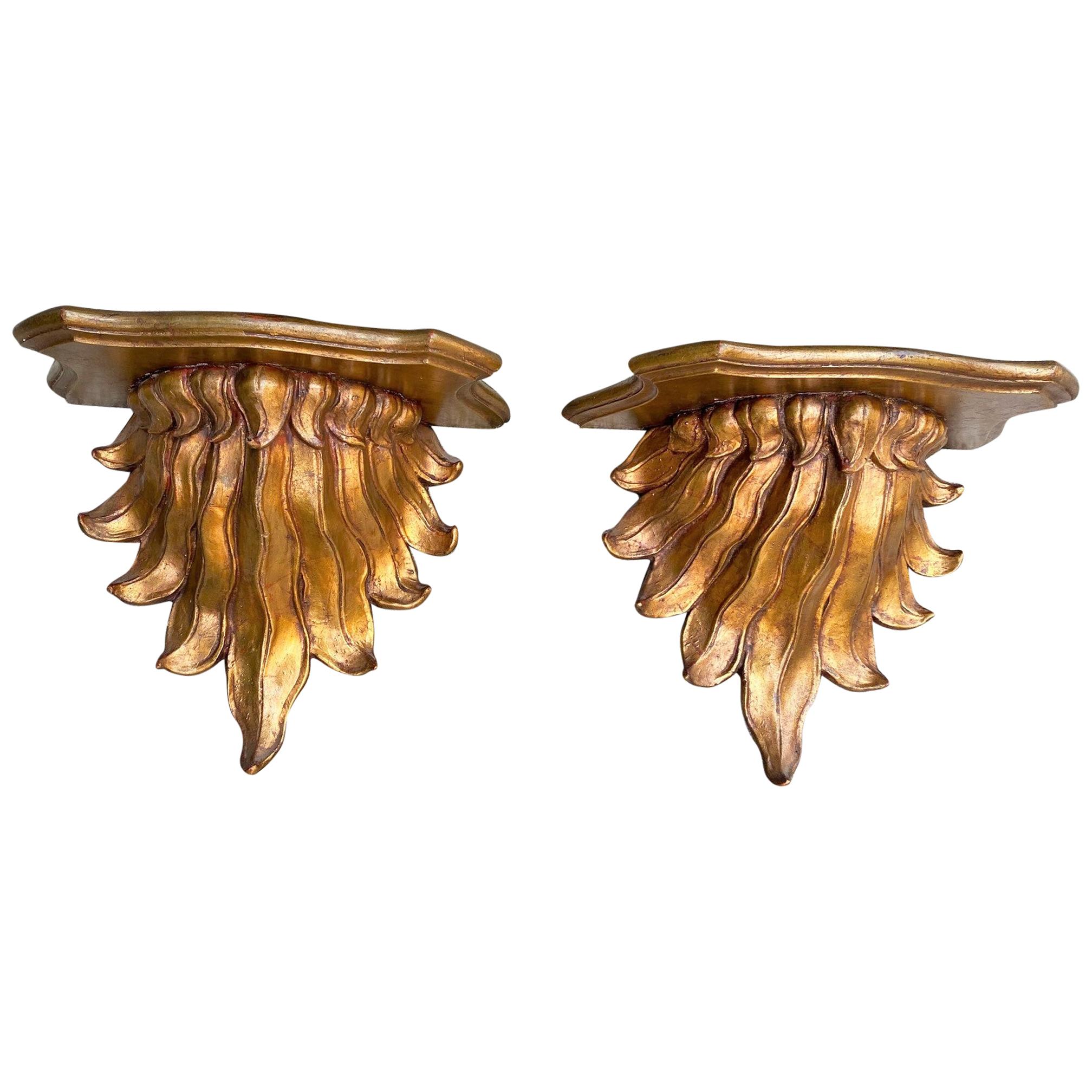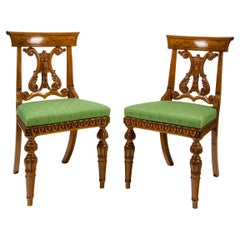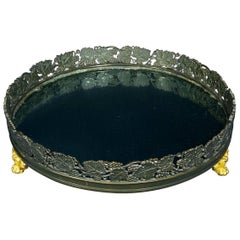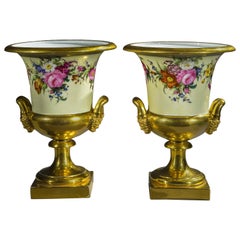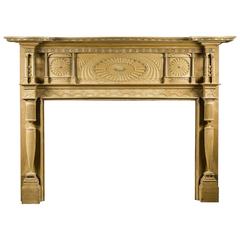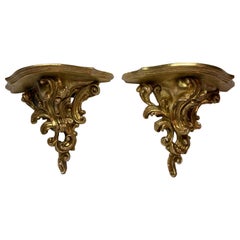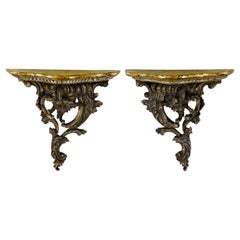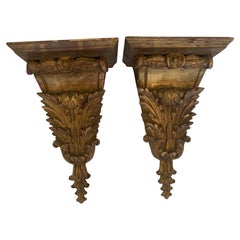Items Similar to Pair of Fern Wall Brackets
Want more images or videos?
Request additional images or videos from the seller
1 of 6
Pair of Fern Wall Brackets
$55,000per set
£41,697.56per set
€48,066.26per set
CA$77,458.67per set
A$85,895.94per set
CHF 45,131.95per set
MX$1,049,502.42per set
NOK 564,662.21per set
SEK 530,031.96per set
DKK 358,824.02per set
About the Item
American, circa 1850-1880.
Eastern white pine (Pinus strobus), with wire armature and composition ornament, gessoed
and gilded.
Measures: 14 1/8 in. high, 16 5/16 in. wide (at the shelf), 9 5/8 in. deep (at the shelf).
Although ferns became an important decorative device during the Aesthetic period in the 1880s, other decorative naturalistic elements in the present brackets suggest that they could date as early as 1850, which is further indicated by the fact that they are made much in the manner of neoclassical brackets of yet a generation earlier.
The date notwithstanding, the brackets are of exceptional quality and, despite the delicacy of their individual components, they have survived in extremely fine condition.
The wood identification was done by wood technologist Harry A. Alden, Alden Identification Service, Chesapeake Beach, Maryland.
Condition: Excellent. A few minor bits of gesso were missing and have been restored. Some ingilding as necessary.
- Dimensions:Height: 14.13 in (35.9 cm)Width: 16.32 in (41.46 cm)Depth: 9.63 in (24.47 cm)
- Sold As:Set of 2
- Style:Aesthetic Movement (In the Style Of)
- Materials and Techniques:
- Place of Origin:
- Period:
- Date of Manufacture:circa 1850-1880
- Condition:Replacements made. Wear consistent with age and use. Condition: Excellent. A few minor bits of gesso were missing and have been restored. Some ingilding as necessary.
- Seller Location:New York, NY
- Reference Number:Seller: FAPG 20521D/21stDibs: LU90322218582
About the Seller
No Reviews Yet
Recognized Seller
These prestigious sellers are industry leaders and represent the highest echelon for item quality and design.
Established in 1952
1stDibs seller since 2010
Associations
Art Dealers Association of America
- ShippingRetrieving quote...Shipping from: New York, NY
- Return Policy
Authenticity Guarantee
In the unlikely event there’s an issue with an item’s authenticity, contact us within 1 year for a full refund. DetailsMoney-Back Guarantee
If your item is not as described, is damaged in transit, or does not arrive, contact us within 7 days for a full refund. Details24-Hour Cancellation
You have a 24-hour grace period in which to reconsider your purchase, with no questions asked.Vetted Professional Sellers
Our world-class sellers must adhere to strict standards for service and quality, maintaining the integrity of our listings.Price-Match Guarantee
If you find that a seller listed the same item for a lower price elsewhere, we’ll match it.Trusted Global Delivery
Our best-in-class carrier network provides specialized shipping options worldwide, including custom delivery.More From This Seller
View AllPair Side Chairs with Lyre Back
Located in New York, NY
“I know of no other chair like the single [sic] ‘lyre back’ one. . . . I certainly recognize it as a Boston chair considering all the individual elements, but the combination is particularly elegant.” So wrote noted scholar of Boston furniture Page Talbott when a set of four chairs of this design originally surfaced in the 1980s. Although the existence of four chairs in a specific pattern might imply that the chairs were originally part of a larger set, no additional chairs of this form have appeared in the intervening years.
The lyre became a popular motif during the Neo-Classical period, and is frequently encountered as the back splat of klismos chairs, in no example more familiar than in a group of Duncan Phyfe chairs...
Category
Antique 1820s American Neoclassical Chairs
Materials
Mahogany
$30,000 / set
Plateau in the Restauration Taste with Grape and Leaf Motifs
Located in New York, NY
French.
Plateau in the Restauration taste with grape and leaf motifs, circa 1825.
Ormolu and patinated bronze, with mirror plate and wood backing.
Measures: 15 7/8 in. diameter, 3 11...
Category
Antique 1820s French Neoclassical Platters and Serveware
Materials
Bronze
Pair of Medici-Form Vases
Located in New York, NY
Attributed to Schoelcher, Paris, France, circa 1830.
Porcelain, painted and gilded.
16 1/4 in. high, 9 1/2 in. wide, 9 1/2 in. deep.
Ex Coll.: by repute, Joseph Bonaparte...
Category
Antique Mid-19th Century French Empire Porcelain
Materials
Porcelain
$25,000 / set
Fan-Carved Wood Mantel in the Federal Taste
Located in New York, NY
New York,
Fan-carved mantel in the Federal taste, circa 1812
Pine
Measures: 66 1/4 in. high, 90 3/8 in. wide, 13 1/4 in. deep
Within the genre of carved rather than plasterwork mantels of the Federal Period, no example that has come to light is more perfectly designed or more carefully wrought than the present one, which is an amazing symphony of fans, urns, beads, and other Neo-Classical devices, all ultimately influenced by the plasterwork designs of the English architects Robert (1728–1792) and James (1732–1794) Adam.
Of a type that proliferated in the area bounded by the northern New Jersey counties of Bergen and Passaic, the Hudson Valley, and western Long Island, the mantel is representative of work that flourished in the first couple of decades of the 19th century. While most of the woodwork of this style that has survived is found in interiors, various examples of exterior doors and other trim have been noted, but most examples have disappeared as a result, variously, of natural deterioration and purposeful demolition in anticipation of development.
Although considerably larger in scale and more elaborate in ornament than a mantel that has been in the collection of the Brooklyn Museum since 1944 (acc. no. 44.55; photograph in Hirschl & Adler archives), the present mantel is so close in style and conception to that example that it likely originated in the same house.
The Brooklyn mantel is documented as having been removed from a house built by Judge Isaac Terhune (1762–1837), an eminent lawyer and judge. The house was situated on King’s Highway, at the corner of Mansfield Place, at the edge of South Greenfield, a village in northern Gravesend, Brooklyn. A photograph of the house, taken by the German e´migre´ photographer, Eugene Armbruster (1865–1933), is in the collection of the New-York Historical Society.
Terhune is ultimately descended from the Dutch-Huguenot e´migre´ Albert Albertson Terhunen, who died in Flatlands, Brooklyn, in 1685.The family eventually spread out through New Amsterdam, Long Island, and Bergen County, New Jersey. Terhune’s great-grandson, also Albert (1715–1806), left a sizable estate to his six surviving children, including his second child and second son, Isaac.
Judge Terhune lived in the house until his death in 1837, at which time, according to an article in The New York Times for November 27, 1910, he, having died without issue, “left the White Frame Mansion with its exquisitely carved doorway, beautiful mantels, and other interior adornments to his brother John” (Part Six, p. 11).
The article continues:
After the latter’s death, the house and its estate of about 70 acres passed through several owners, eventually being purchased in 1853 by Benjamin G. Hitchings [1813–1893].
The house next passed to Benjamin’s son, Hector, who had been born in the house, and then lived there for 25 years. He sold it in 1910 in partial payment for a Manhattan apartment house. After thus having been sold to a real estate developer, the Hitchings property was subdivided into Hitchings Homestead. The house survived until about 1928, at which time it was razed and a Deco-style apartment house with the address 2301 Kings Highway was constructed on the site and occupied in 1935.
By 1910, the fate of the house, in an area of Brooklyn that was being rapidly developed, was becoming obvious. The Times article reported:
The house has been well kept up, but fearing lest the hand of time or vandals might deal harshly with some of its choice bits of carving, Mr. Hitchings removed a few years ago a few beautifully carved wood mantels...
Category
Antique 1810s American Neoclassical Fireplaces and Mantels
Materials
Wood
Monumental Overmantel or Pier Mirror in the Aesthetic Taste
Located in New York, NY
American, third quarter of the 19th century.
Pine, gessoed and gilded, with mirror plate.
Measures: 81 ½ in. high, 59 ½ in. wide.
Condition: Excellent. The gilding has been cleaned and very, very slightly inglided as necessary. The ball at the upper left was missing and has been replicated based upon...
Category
Antique 19th Century American Aesthetic Movement Pier Mirrors and Consol...
Materials
Mirror, Pine
Pier Mirror in the Neoclassical Taste
Located in New York, NY
New York, circa 1815-1820.
Wood, gessoed and gilded, with mirror plate.
75 1/2 in. high, 44 1/8 in. wide (at the cornice), 8 1/2 in. deep (at the cornice).
Condition: Some restorati...
Category
Antique 19th Century American Neoclassical Pier Mirrors and Console Mirrors
Materials
Mirror, Wood
You May Also Like
Large Pair of Rococo Style Brackets
Located in East Hampton, NY
Impressive pair of gilt Rococo style carved wood wall brackets.
Category
Mid-20th Century Rococo Wall Brackets
Materials
Wood
$2,100 / set
Antique French Baroque Style Wall Bracket, a Pair
Located in Plainview, NY
A pair of French Baroque style hand carved gesso and wood floral scroll design wall brackets featuring a scalloped gild painted shelving. This elegant...
Category
Early 20th Century French Baroque Wall Brackets
Materials
Wood, Paint, Gesso
$880 Sale Price / set
60% Off
Pair of Mid-20th Century Decretive Wall Brackets
Located in San Francisco, CA
Pair of Mid-20th Century Decretive Wall Brackets
Brass with wood
11" x 9.5"
Category
Mid-20th Century Wall Brackets
Materials
Brass
Elegant Antique Pair of Carved and Gilded French Wall Brackets
Located in Hopewell, NJ
Superbly elegant pair of French antique carved and gilded wood wall brackets adorned with acanthus leaves.
Category
Vintage 1910s French Wall Brackets
Materials
Wood
Pair Of 19th Century Italian Gilt Wall Brackets
Located in Bradenton, FL
Pair of 19th century Italian gilt wall brackets. Brackets have beautifully carved and painted acanthus leaves topped with a flat shelf. Wonderful old patina. Brass hardware is affixe...
Category
Antique 19th Century Italian Baroque Wall Brackets
Materials
Wood
Pair Gilded Brackets Decorative Wall Mount Decoration Shelves Antique LA CA
Located in West Hollywood, CA
Pair Gilded Brackets Decorative Wall Mount Decoration Shelves Antique LA CA . Finely carved Demilune and water gilt Pair of wall brackets Scrolled foli...
Category
20th Century European Neoclassical Wall Brackets
Materials
Other
$3,360 Sale Price / set
30% Off
More Ways To Browse
Antique Curtain Brackets
Angel Bracket
Tole Shelf
Pair Wall Sconce Shelves
Eagle Wall Brackets
Henry Wilson Hook
Indian Wall Shelf
Chinoiserie Wall Brackets
Pair Of Italian Corbels
Black Forest Carved Wall Bracket
Elephant Wall Brackets
Corbels Church
French Curtain Rod
Monkey Wall Bracket
Corbel Wall Shelves Pair
Gold Wall Sconce Shelves
Parrot Wall Brackets
Curtain Pole
